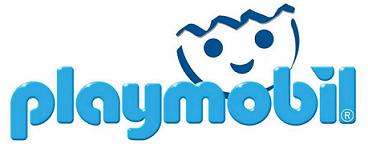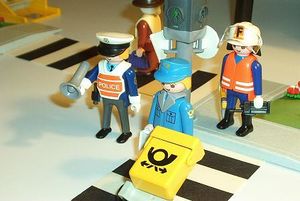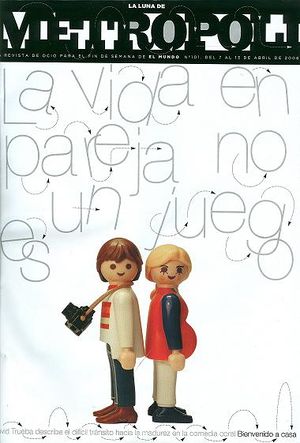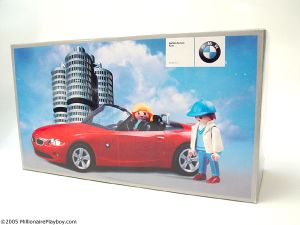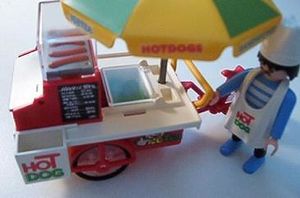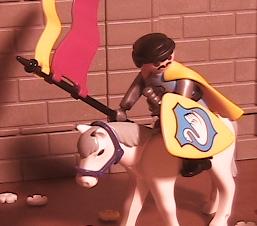Playmobil
Playmobil (pronounced "play-mo-beel", and occasionally referred to as just Playmo) is a line of toys produced by the Brandstätter Group (geobra Brandstätter GmbH & Co KG), headquartered in Zirndorf, Germany.
New products and product lines developed by a 50-strong development team are frequently introduced by Brandstätter. Some of these, such as promotional products, are only produced in limited quantities. For example, Playmobil introduced limited edition sets with the logos of seven different airlines, sold only aboard flights and in duty-free shops. These practices have given rise to a sizable community of collectors. Collector activities extend beyond collecting and free-form play with Playmobil and include customization, miniature wargaming, and creation of photo stories and stop motion films.
Contents
- 1 History of Playmobil
- 2 The history of Playmobil: issues, controversies, authorized and unauthorized figures
- 3 Current Playmobil product lines
- 4 Playmobil FunParks and FunStore
- 5 Playmobil movies
- 6 Playmobil video games
- 7 Playmobil in art
- 8 Playmobil in the media
- 9 Playmobil in music video
- 10 See also
- 11 External links
- 12 History of Playmobil sources
History of Playmobil
Hans Beck (b. 1929) is often called "The Father of Playmobil." Beck received training as a cabinetmaker but worked simultaneously on model airplanes, a product he pitched to the company geobra Brandstätter. The owner of the company, Horst Brandstätter, asked him to develop toy figures for children instead.
Beck spent three years developing what became Playmobil. Beck conducted research that allowed him to develop a toy that would not be too complex but nevertheless flexible. Playmobil hands were capable of gripping and holding objects. The toy, at 7.5 cm, would also fit in a child's hand and its facial design would be based on children's drawings (large head, big smile, no nose). "I would put the little figures in their hands without saying anything about what they were," Beck remarked. "They accepted them right away....They invented little scenarios for them. They never grew tired of playing with them."[1]. Earlier figures had arms of one piece and another piece for the legs. Later sets allow hand rotation and independent leg and foot movement.
The 1973 oil crisis made it possible for Playmobil to be considered a viable product. Rising oil prices imposed on geobra Brandstätter, for whom Beck worked as Head of Development, demanded that the company turn to products that required less solid plastic material (during the 1960s, the company had been producing hoola-hoops and large plastic toys).
In 1974, the company put the series on show in its display rooms. Initial visitors were reluctant to accept the toy. Nevertheless, the toy was shown at the International Toy Fair in Nuremberg, which was taking place that same year. The toy remained popular with children. A Dutch firm subsequently agreed to buy a whole year's production.
Playmobil began to be sold worldwide in 1975.
Playmobil pop-up books, in which buildings and settings corresponded to the height of actual Playmobil figures, were sold for a time, as well as a series of comic books, coloring books, and puzzles.
Playmobil has been a successful toy line for more than 25 years and they have been a major competitor to Lego toys. Examples of directly competing toys in both their product line are not hard to find. Within the limitations of the Playmobil toy world, the Playmobil toys are usually realistic and accurate representations of arms, armor, costumes, and tools from a recognizable time period. Especially notable for a fine attention to detail are the modern construction and city life toys (cars, cranes, fire-engines, trains, etc.).
Playmobil toys are specifically aimed at children from the ages of six to twelve. The company believes that older children tend not to play with these types of toys and so it has resisted creating toys from other, less well known, historical time periods.
The history of Playmobil: issues, controversies, authorized and unauthorized figures
- The first Playmobil sets were of Native Americans, construction workers and knights. The construction worker set included a wheelbarrow, a road roller, ten traffic cones, as well as three crates holding 18 bottles of beer. The German Ministry of Youth intervened in response to this set's packaging, which showed two Playmobil figures discussing their beer consumption ("That's my fifth bottle today." "Don't worry, we've got enough beer.")[2]
- In Spain, they were licensed by Famosa, a leading dollmaker, and marketed as "los clicks de Famobil". Spanish package marked the quantity of male dolls (clicks) and females (clacks). Females are distinguished by hairdo and a wider chestpiece suggesting a skirt.
- In the seventies, Playmobil was licensed by a company called Lyra in Greece.
- In Argentina Playmobil is licensed by Antex, for distribution in South American markets. Former South American licensees included Brazil's Industria de Brinquedos do Amazonas and Peru's BASA.
- In 1978, Schenk, a Hungarian firm, began reproducing bootleg Playmobil figures. They had not received any authorization or license from geobra Brandstätter. Schenk produced exact copies of the original toy, though some sets were modified to create new types of sets, usually military, from Hungarian history. Thus, Schenk produced the Hussar (Huszár), from the period of the Hungarian War of Independence and the Hungarian hussar series (Magyar huszár sorozat). Other sets included the Austrian soldier (Osztrák), Turkish soldier (Török), William Tell (Tell Vilmos), and the Hunyadi series (Hunyadi sorozat). Schenk figures, like the early Playmobil figures, do not have moveable hands. But unlike the Playmobil horses, the Schenk horses do not have moveable heads. Schenk figures also bear different colors from their Playmobil counterparts. They were also made with inferior plastic. Following the collapse of communism, a 1995 court ruling forbade the manufacture and distribution of the Schenk figures. The owner of Schenk, Károly Schenk, was allowed to sell of his remaining toy figures only in Hungary until March 1996. However, Schenk bootlegs may still be available in toy shops in Hungary. Bootleg sets have been manufactured and sold in China in recent years. These sets are not marketed as Playmobil, though they are identical in terms of appearance (but not in regards to quality). Sets include a "Noshery" (fast food eatery), "Pirate Island," and medieval figures.[3]
- In 1982, McDonald's ceased distribution and promotion of Playmobil at its restaurants after tests showed that the toy failed to comply with Consumer Product Safety Commission tests designed to prevent children under three from choking on dangerous items (The Playmobil toys, however, were not involved in any reported choking incidents). The five Playmobil toys that were to be distributed nationwide included a Sheriff, Indian, Sheriff's Horse, Umbrella Girl and Farmer. Approximately 10 million of the Sheriff and Indian Playmobil toys were actually distributed from October 22 through November 1, 1982. McDonald's customers with children under three who received these toys were advised to discontinue their use and return the toys to a McDonald's in exchange for a box of cookies, a cone, or a refund.
- Over the years, some proposed sets have included Chinese Railroad Workers and a Grave Digger for the Western theme, as well as a Medieval Torture Room. Prototypes were made. However, these sets were considered insensitive and inappropriate for young children, and were never released. There are however sets including ghosts and a mummy containing a skeleton.
- In 2004 BMW licensed the familiar Playmobil look and feel to release an exclusive BMW Z4 done in Playmobil scale. It also came with two Playmobil passengers. Originally, the only way to get one of these Z4s (available in deep red or blue) was to take a test drive at a BMW dealership in Germany. Shortly thereafter, versions in a pale yellow or eggshell blue were available in European toy stores. Though not manufactured by Playmobil, they were officially licensed. A similar product is still available on BMW's website for $35.00 usd
Current Playmobil product lines
- Rescue
- Knights
- Zoo
- RC Train
- Police
- Vikings
- Adventure
- Leisure
- Christmas
- Airport
- Easter Bunnies
- Pirates
- Farm
- Supermarket
- Fairy Tale Castle
- Modern Living
- Dollhouse
- Construction
- Soccer
- Special
- Super Sets
- 1-2-3
- Dino Expedition
- Rally
- Add Ons
- First Smile
- Racing
- Romans
Playmobil FunParks and FunStore
- Athens, Greece
- Malta
- Orlando, Florida, USA
- Palm Beach Gardens, Florida, USA
- Paris, France
- Zirndorf, Germany
- FunStore Woodbridge, New Jersey, USA
Playmobil movies
Using the technique of stop-motion, fans have created a number of films with Playmobil. Directors' names are in parentheses.
- The Adventures of Pete & Rob, Several short Flash stop-motion films (P. Roessler)
- Bloody Snow, a Western (Sven van der Hart)
- The Viking Five, a comedy (Sven van der Hart)
- Santa's New Ride, a comedy (Sven van der Hart)
- The Fountain of Youth, a medieval epic (Paul Morris)
- A variety of Playmobil movies at Collectobil including Heir to the Throne, a medieval epic, and
- The Three Bandidos, a Western (both directed by Joshua Deicken).
- Macromedia Shockwave films spoofing the Blair Witch Project can be found at Blairmobil (Andrew Jones)
- German language films, including Circusliebe (Dirk-Malte Bornemann, Ralf Bühlichen), Drehpannen, Bruno Filmt Claire, and Christmasspecial, can be found at Pics-by-pix.
Playmobil video games
- Alex Builds his Farm: A game for young children helping Alex throughout the farm.
- Hype: The Time Quest: When Hype is cast back into time by an evil dragon knight he must strive hard to find the jewels that will take him forward through time, Gogood, a magician, also plays a part in the story by helping Hype.
- Laura's Happy Adventures: A magical adventure set in and around the Playmobil Doll's House that begins when Laura discovers an enchanted diamond in her grandfather's rock collection.
Playmobil in art
- German artist Loka Daun and Austrian art group monochrom created "Bio Squad", a satirical photo series dealing with biological warfare.
Playmobil in the media
- Rede Globo made a soap opera called Bang Bang that featured an opening sequence which clearly resembles Playmobil's Old West toys (which were very popular in the 1980s in Brazil). A very popular comedy in Greece, Sto Para Pente (2005- ), also uses playmobil - like characters, which resemble the leading actors in the opening sequence.
Playmobil in music video
- Venus Hum made a video for their song, "Fighting For Love", with Playmobil characters in it.
See also
External links
| Wikimedia Commons has media related to: Playmobil |
- (English) Playmobil official homepage
- (German) Claudia Schott Collectorpage
- (English) Collectobil
- (English) Gardenwargaming.com
- (French) Ludoplaymo
- (English) Playmoboard community forum
- (Spanish) Playclicks community forum
- (French) Playmofrance community forum
- (English) PlaymoFriends community forum
- (German) Playmo-Portal community forum
History of Playmobil sources
- Cheerful Plastic Figures from Franconia – Playmobil Conquers the Playroom, Goethe-Institut
- Playmobil Toys Article
- Ruth Walker "One Man's Tiny Plastic Universe," Christian Science Monitor, 1997
- The swashbuckling Playmobil pirate captures children's imaginations
- McDonald's Voluntarily Stops Playmobil Promotion And Recalls; November 3, 1982
- Schenk Bootlegs Playmobil in Hungary
de:Playmobil es:Playmobil fr:Playmobil he:פליימוביל nl:Playmobil ja:プレイモービル no:Playmobil pt:Playmobil sv:Playmobil
